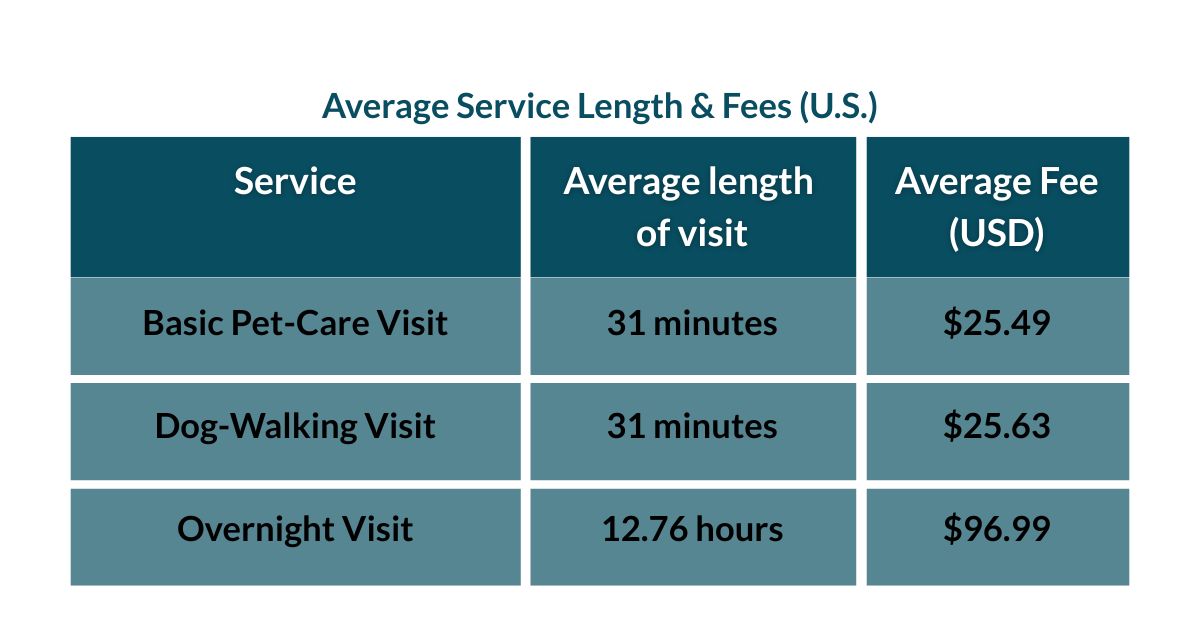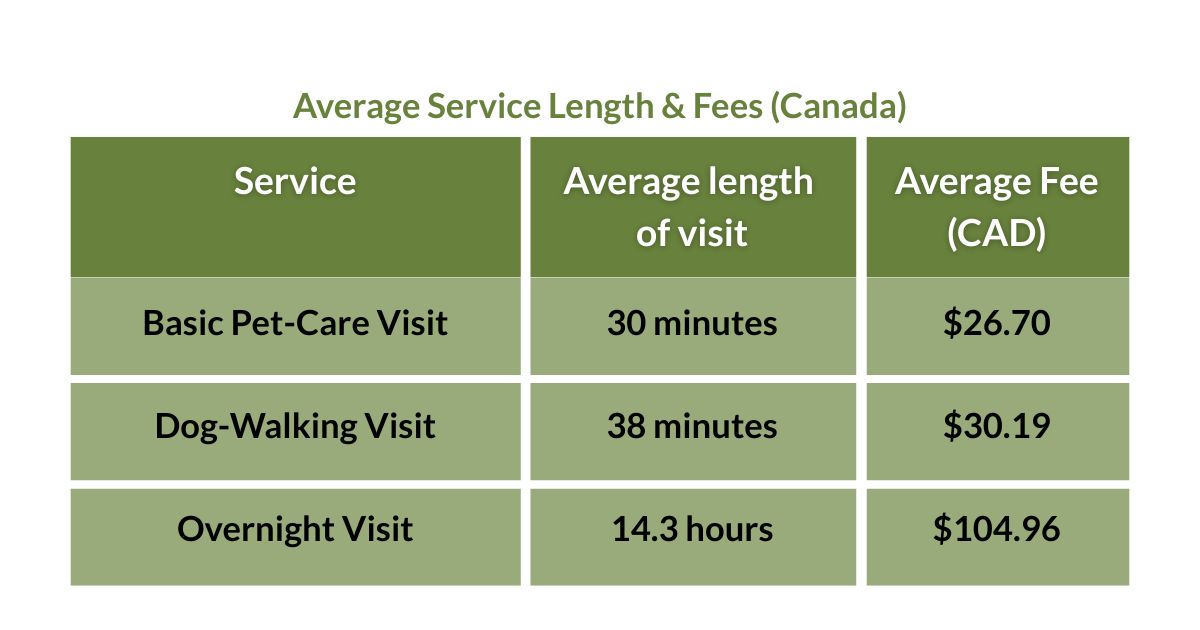How to Set Your Pet-Sitting and Dog-Walking Rates (2025)
May 2025 | Beth Stultz-Hairston, Pet Sitters International
What should I charge for pet sitting? What should I charge for dog walks? What should I charge for overnight pet sitting?
These are some of the most common questions we receive at Pet Sitters International—and for good reason. Deciding on rates is one of the most important decisions for a pet-care business.
It can be difficult to find information on this topic because service providers (including pet sitters and dog walkers) are prohibited from discussing specific pricing details in group settings or in online groups due to anti-price fixing laws. Many pet sitters don’t realize this, but if you participate in online chat groups that discuss specific rates, you should be careful as you may be violating these laws!
Fortunately, pricing can be discussed in general terms and industry averages. PSI’s State of the Industry Survey includes questions on rates and services, and we can share that information with you.
Consider National Averages for Pet-Sitting Services
PSI surveys its more than 4,000 member businesses every two years on topics including pet-sitter demographics, rates, income, business size and types of services provided. The survey results are used to develop an accurate PSI member profile and to examine industry trends.
The information provided below is from PSI’s most recent State of the Industry Survey (2024).
Below are the average rates for various services offered by PSI member businesses:

Research Your Local Pet-Care Market
Keep in mind that the rates highlighted above are national averages. Typical rates may vary greatly depending upon where your business is located.
To get a better idea of the pricing range for pet-care services in your area, you should research what other professional pet sitters, boarding facilities, and doggie daycares in your area charge. Generally, boarding facilities and daycares may be slightly less expensive for one dog (when compared to the cost of 3-4 daily pet-sitting visits) but are often considerably more expensive for multiple pets, as most professional pet sitters charge by time instead of a flat, per-pet fee.
Because most pet sitters and dog walkers have business websites, you will likely find it easy to locate the rates of local pet-care businesses online. However, if you find that you will need to contact a pet sitter or dog walker directly to inquire about rates during your research, be honest. You should never pose as a potential client when gathering this information. Always be upfront and explain that you are starting a new professional pet-sitting business or have a pet-care business and are researching local rates. This initial contact could lead to a great networking opportunity!
When comparing rates to other pet sitters and dog walkers in your area, be sure to differentiate between professional pet-sitting and dog-walking businesses and hobbyists. As a professional pet sitter or dog walker, you should compare your prices with other professional pet-care businesses who maintain pet-sitter insurance, obtain an appropriate business license or home business permit, if required, etc.
Individuals/gig workers who advertise on pet-sitting platforms and apps (but don’t actually operate their own business) and other non-professional sitters are able to offer unrealistically low rates because they do not have the same overhead costs for professional credentials, so they do not provide an accurate comparison for your services.
Don’t Just Rely on Comparisons
Local market research will help you determine typical rates in your area and identify where your rates fall within that range, but don’t base your pet-sitting and dog-walking fees on your competitors’ rates alone. Your competitors may have different credentials, clients, and costs, all of which have an impact on what they charge.
In addition to the going rates in your local market, there are other factors you should consider. Remember, when setting fees, you’ll want to do some calculations to anticipate what your overhead business costs will be. These expenses include insurance and bonding, travel expenses, phone bill, advertising, etc. If you have staff or plan to use staff sitters in the near future, you should also consider those associated costs and ensure that your rates allow you to compensate staff sitters while still maintaining a profit for you and your business.
In her online training session, Pricing Strategies for a Changing Landscape, presented during PSI’s Thriving Through Change: Smart Strategies for Pet-Care Pros webinar series, Anne-Marie Kaden, Tiny Paws Bookkeeping, shared these key factors that should influence your pricing as a pet-care service provider:
- Time and labor costs
- Overhead expenses
- Market research
- Target clientele
- Service tiers (standard vs. premium services)
You cannot decide what to charge for pet-sitting services if you don’t first know your numbers. As a business owner, you have direct costs (i.e., fuel, treats, etc.), as well as overhead costs (i.e., insurance, software, marketing, etc.).
Then, you must understand your labor costs—for yourself and your team, if applicable—and don’t forget taxes (self-employment or payroll tax).
So how do these all factor in to what you charge? Anne-Marie shared these industry benchmarks to keep in mind when setting your rates:
- Labor costs: 45-50%
- Overhead expenses: 20-30%
- Profit: 20-30%
Consider Time-Based vs. “Itemized” Pricing
Once you’ve factored in your overhead costs and profit margin and determined what you need to charge, you may also wonder if additional pets or small extra services should impact your service fee.
We do sometimes hear from pet sitters who choose to charge a per-pet fee for pet-sitting services (e.g., a base rate for one pet + an additional fee per additional pet in the home), or who have a base rate, but then charge extra if the pet needs to be given medicine, for example.
However, charging by time—with standard rates for a 30-minute, 45-minute and/or 1-hour visit, for example—is the industry norm, and for good reason.
Charging by time (length of visit) typically simplifies your company’s billing and recordkeeping processes, and this fee structure is often easier for clients to understand (and they don’t feel “nickeled and dimed”).
Using a fee structure based on time can also make it easier to factor in personnel expenses (and determine wages) if you have staff sitters or walkers.
That doesn’t mean you should never consider additional fees. Holiday surcharges, late booking fees, and cancellation fees are common in our industry, so you will want to consider what works best for you and your business model.
Clearly Communicate Your Rates
Once you’ve determined what your company will charge for the services you offer, make sure you communicate these rates clearly to current and potential clients.
Your company website should clearly outline your service options and the corresponding rate. Prospective clients shouldn’t have to search for your rates—and if they do have to search/can’t find your pricing information, many will just move on to the next website!
Some pet-care services have expressed concerns that having their rates publicly available could discourage price-conscious pet parents before the pet sitter has the chance to explain their value. Here’s the reality: your rates will fall outside some pet owner’s budgets, and that’s okay. They are not your ideal client. However, it is a good idea to highlight the value of your services in the descriptions included on your website. Don’t simply say, “30-minute visit: $30,” for example. Instead, also include a description of what that visit includes, such as: “$30 for 30-minute visit, which includes feeding, changing water bowls, exercise/playtime, litter box cleaning, and lots of TLC!”
Remember, too, that your knowledge and expertise have value, so be sure to also highlight your pet-sitting credentials and experience. Here are some quick tips for communicating your value to your pet-sitting clients.
Other pet sitters have shared they are hesitant to list specific prices on their website because they are afraid that once they meet the client for the initial consultation, they may discover that the client’s specific requests cannot be accommodated for the standard 30-minute visit fee, for example.
This is another simple fix. If you have this concern, when listing the standard rates for your 30- or 45-minute visits, you can consider saying, “30-minute: starting at $30,” or list your rates for your various visit length options and include a note that says: “We’ll discuss your specific pet-care needs at your complimentary initial consultation to determine the visit option that will work best for your pet.”
Your rates, along with your payment policies (e.g., when payment is due and payment methods accepted), should also be listed at the bottom of your pet-sitting contract or in an attached document to be signed by clients when they first book service. When you update your rates in the future, your new fee schedule should be provided to clients; they shouldn’t be surprised by different rates at the end of a pet-sitting assignment!
Your Rates Will Change
There are various factors that may prompt (or force) you to raise your rates throughout your pet-sitting career.
Oftentimes new pet sitters find that they set their rates too low initially, are priced well below other professionals in their service area and can’t maintain a profitable business at their current rates.
Even for pet sitters who use the “formula” outlined above to set their rates when they started pet sitting, a rate increase will eventually be needed (and likely many times throughout your pet-sitting career). As with any other industry, business and economic changes necessitate regularly reviewing your rates to ensure your fees remain competitive but also allow you to continue to operate a professional and profitable pet-sitting service.
Your reason for increasing your rates may be the increased cost of doing business—business license, insurance, bonding and certification fees or even travel expenses due to the rising cost of fuel. You may change your business model and need to update your rates now that you use staff sitters. Some professional pet-sitting business owners even decide to raise their rates to appeal to a specific type of clientele who seek out premium services.
Businesses in all industries re-evaluate their fees and adjust their pricing structures due to rising costs of supplies and resources, the need to increase pay to attract staff, and a variety of other factors. So, if you are raising your rates, you are not alone—and your clients will likely not be surprised at all!
Keep in mind that even a small rate increase can have an extremely positive effect on your bottom line.
Not sure how to let your clients know about a rate increase? This PSI blog post shares factors to consider when deciding how and when to share pet-care service fee changes with current clients.
Not a PSI member? We invite you to download PSI's Information Packet to learn how PSI membership gives you access to the credentials, continuing education and community you need to succeed in the pet-sitting industry.








Comments
No comments.